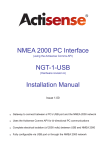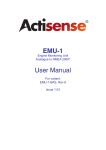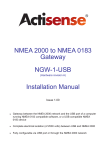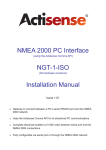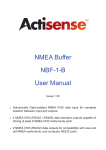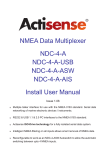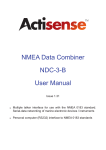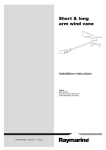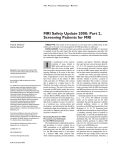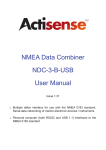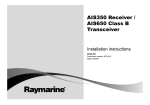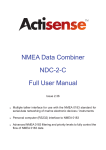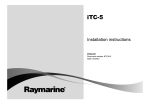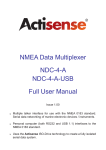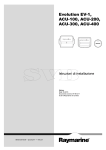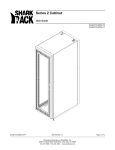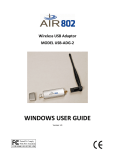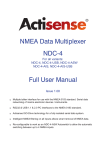Download Actisense NGW-1 User Manual issue 2.03
Transcript
NGW-1 NMEA 2000 to NMEA 0183 Gateway User Manual For all variants: NGW-1-ISO, Rev A to C NGW-1-ISO-AIS, Rev A to C NGW-1-STNG, Rev A to C NGW-1-USB, Rev A to B Issue 2.03 NMEA 2000 to NMEA 0183 Gateway - NGW-1 Contents Important Notices The NGW-1 Product Range Software Updates Connecting to the NMEA 2000 Network 4 4 4 5 Connecting to a SeatalkNG Network Connecting to a USB Port USB Driver Installation Windows Port Number Configuration Connecting a Standard NMEA 0183 Device 5 5 5 5 6 Connecting to an RS232 (PC) Port 7 Connecting to an RS485 (IEC 61162-2) Listening Device 7 Connecting a Custom Cable 8 Configuring the NGW-1 9 Troubleshooting Guide 10 Specifications 11 NGW-1 Product Order Codes 12 NMEA 2000 Networks NMEA 2000 Minimum Network Requirements Table 1 - NMEA 0183 Connections Figure 1 - NMEA 0183 Connections Figure 2 - PC / RS232 Port Connections Figure 3 - RS485 / IEC 61162-2 Port Connections Opening the NGW-1 Case Custom NMEA 2000 Cable Figure 4 - NMEA 2000 PCB Connections Custom NMEA 0183 Cable Table 2 - NMEA 2000 Connection Table Configuring using NMEA Reader Connecting the NGW-1 to NMEA Reader Changing the Baud rate Special ARL P-codes Selecting PGNs for conversion Status LEDs Table 3 - Diagnostic LED Technical Support and the Returns Procedure Table 4 - Specifications © 2015 Active Research Limited 5 5 6 6 7 7 8 8 8 8 8 9 9 9 9 9 10 10 10 11 Page 3 Important Notices The NGW-1 Product Range Actisense and the Actisense logo are registered trademarks of Active Research Limited. All rights are reserved. The contents of this manual may not be transferred or copied without the express written permission of Active Research Limited. All other trademarks are the property of their respective owners. The NGW-1 range allows NMEA 0183 electronic equipment to be connected to a vessel’s NMEA 2000 network. This will allow equipment installers to adopt the NMEA 2000 network early, whilst connecting any existing NMEA 0183 devices to the new bus standard. The Actisense NMEA 2000 to NMEA 0183 Gateway (NGW-1 and its variants) are intended for use in a marine environment, primarily for below deck use. If an NGW-1 unit is to be used in a more severe environment, such use may be considered misuse under the seller’s guarantee. The NGW-1 has been certified to comply with the European directive for Electromagnetic Compatibility (EN60945), and is appropriately CE marked. Operation of the unit should be in conjunction with appropriate CE approved shielded connectors and cabling used in accordance with the CE directive EN60945. Any EMC related issues should be reported to Active Research Limited immediately to allow the company to rectify or resolve EMC related problems in accordance with its obligations under EN60945. When using this document, please note the following: The products described in this manual and the specifications thereof may be changed without prior notice. To obtain up-to-date information and/or specifications, contact Active Research Limited or visit the Actisense website (www.actisense.com) Active Research Limited will not be liable for infringement of copyright, industrial property right, or other rights of a third party caused by the use of information or drawings described in this manual. The NMEA Gateway can transfer data from an NMEA 0183 source and place that data on the NMEA 2000 bus, or it can take NMEA 2000 data from the NMEA 2000 bus and make it available to the NMEA 0183 instrument. Please refer to the NGW-1 Conversion List for details of all conversions that can be performed by the NGW-1 (and just as importantly those that cannot): You will notice there are two conversion lists, one for the standard firmware and another for the AIS version. Full information on the complete Actisense product range and supporting software packages can be found on the Actisense website (www.actisense.com). Software Updates The NGW-1 units have built-in firmware which is held in “flash” memory, allowing quick and easy upgrades using the latest NGW-1 ActiPatch. It is highly recommended that the firmware is updated to the latest version, which can be found on the NGW-1 Firmware page. Supporting software may also be available for your device. Active Research Limited will not be held responsible for any damage to the user that may result from an accident during operation of this unit when used in accordance with this document. © 2015 Active Research Limited Page 4 NMEA 2000 to NMEA 0183 Gateway - NGW-1 Connecting to the NMEA 2000 Network Actisense supplies a pre-fitted four-core screened cable for the NMEA 2000 connection, fitted with a male micro-fit connector. Simply connect the cable to the network backbone using a T-peice connector. NMEA 2000 Networks NMEA 2000 Minimum Network Requirements NMEA 2000 devices will only communicate with each other when connected to a powered and correctly terminated NMEA 2000 network. It is not enough to simply connect two NMEA 2000 devices directly together. All NMEA 2000 networks require a 12 VDC supply. All networks need to be powered and terminated correctly to allow data to be transmitted on the network. T-Peices are needed to connect each device to the network. Additional cable lengths can be used between any of the connectors to extend the length of the network. • 1 x Power-T • 2 x Terminating Resistors • 2 x T-Peices (one per connected device) All the required network parts are supplied by Actisense. Note: Refer to “Status LEDs” on page 10 for LED behaviour. Connecting to a SeatalkNG Network The NGW-1-STNG is a standard NGW-1-ISO unit with the addition of a SeatalkNG to NMEA 2000 adapter cable supplied in the box. Connect the adapter between the NMEA 2000 cable of the NGW-1 and the SeatalkNG backbone. SeatalkNG, like NMEA 2000, requires a fully functional network to connect devices together. It is not possible to connect the NGW-1 directly to a SeatalkNG device without a powered and terminated network being present. Refer to your Raymarine® product manual for instructions on creating your SeatalkNG network. Connecting to a USB Port Simply connect the USB cable on the NGW-1 to the PC port and install the drivers. A USB to serial converter cable can be used to connect the non USB variants to a PC USB port. For wiring the converter cable refer to “Connecting to an RS232 (PC) Port” on page 7. Note: Refer to “Status LEDs” on page 10 for LED behaviour. USB Driver Installation Windows 7 will automatically install the drivers from Windows Update if there is an active Internet connection the first time the NGW-1 is plugged in. If the PC is not connected to the Internet or if the USB driver does not install automatically on the first installation of the NGW-1, the ‘Update Driver Software’ option in Device Manager will need to be used to install the USB drivers manually. Windows versions that use the ‘Found New Hardware Wizard’ should be directed to automatically search for the best driver. Include ‘Search Windows Update’ or ensure the Actisense CD is inserted. For other operating systems and step-by-step guides refer to the ‘USB Install Manual’. © 2015 Active Research Limited Windows Port Number Configuration The port number for the NGW-1 can be found in Windows ‘Control Panel->System->Device Manager’ under ‘Ports (COM & LPT)’. Find the NGW-1 in the list for the USB variant. When using a USB to serial converter cable you will see the name of the converter cable with no reference to the NGW-1. If you have connected to an RS232 port on the PC this will be listed as a ‘Communications Port’, again with no reference to the NGW-1. To change this number, double click the NGW-1 and select the ‘Port Settings’ tab. Click the ‘Advanced’ button and change the port number to the one required. Page 5 Connecting a Standard NMEA 0183 Device Actisense supplies a pre-fitted four-core screened cable for connecting devices that comply to the NMEA 0183 specification. Actisense ISO-Drive output circuitry and OPTO input circuitry allows many different types of device to be connected without the need for configuration. Voltage levels are managed automatically as well as accepting both differential and ground referenced connections safely. The standard wiring connection can be seen in “Figure 1 - NMEA 0183 Connections”. Note: Refer to “Status LEDs” on page 10 for LED behaviour. Wire Colour Wire Name (Function) PCB Label Connnects To Black Opto In B / - (NGW-1 Listener -ve) IN B / - Talker OUT B / - / GND Red Opto In A / + (NGW-1 Listener +ve) IN A / + Talker OUT A / + / Data Blue ISO Out B / - (NGW-1 Talker -ve) OUT B / - Listener OUT B / - / GND White ISO Out A / + (NGW-1 Talker +ve) OUT A / + Listener OUT A / + / Data Shield / Screen Ground ISO GND Not Connected Table 1 - NMEA 0183 Connections NGW-1 NMEA 0183 DEVICE Arrows indicate direction of data flow B/- / GND NMEA A/+ / TX Talker/Out B/- / GND NMEA A/+ / RX Listener/In Do not connect Figure 1 - NMEA 0183 Connections © 2015 Active Research Limited Page 6 NMEA 2000 to NMEA 0183 Gateway - NGW-1 Connecting to an RS232 (PC) Port The NGW-1 can be connected to a PC communications (RS232) port using the supplied cable and a connector with the following specification: 1. A minimum of 3-cores are required in a shielded cable. Higher quality cable will naturally yield higher performance/ higher Signal-to-Noise Ratio (SNR). Most typical cables have two twisted pairs inside. In this case, use one pair for the TX line and one for the RX line. Use the spare wire in each pair as ground, and connect the cable shield to ground only at the computer end. 2. A DB9 (9 pin D-type) type female (socket) connector for the PC end of the cable. 3. The OUT +/A of the NGW-1 should be connected to the RX of the computer (standard 9 pin D-type, pin 2) and the NGW-1 IN +/A should be connected to the TX of the computer (standard 9 pin D-type, pin 3). 4. Connect the IN -/B and OUT -/B together and connect to the PC’s serial port ground (standard 9 pin D-type, pin 5). Note: To change the port number used in Windows refer to “Windows Port Number Configuration” on page 5. Note: Refer to “Status LEDs” on page 10 for LED behaviour. NGW-1 COMPUTER Arrows indicate direction of data flow TX Pin 3 RX Pin 2 GND Personal Computer ( 9 PIN 'D' RS232 Port) Pin 5 Do not connect Figure 2 - PC / RS232 Port Connections Connecting to an RS485 (IEC 61162-2) Listening Device The ISO-Drive output of the NGW-1 can be connected to an RS485 Listener that requires differential drive plus a ground connection as shown in “Figure 3 - RS485 / IEC 61162-2 Port Connections”. Note: Refer to “Status LEDs” on page 10 for LED behaviour. NGW-1 RS485 DEVICE Arrow indicates direction of data flow B/A/+ GND RS485 Listener Figure 3 - RS485 / IEC 61162-2 Port Connections © 2015 Active Research Limited Page 7 Connecting a Custom Cable It is possible to replace the supplied cables with custom cables for different applications. The cables are connected inside the case using screw terminals so that it is easy to swap out the existing cable for one more suited to the installation requirements. A spare cable gland is supplied for strain relief and splash proofing. Opening the NGW-1 Case To open a NGW-1 case, remove the two screws in the base of the unit, then carefully lift off the top of the case. The cable glands must be slid out from the top of the case in order to access the internal connections. Pulling the lid off too roughly without sliding the glands out may damage the cable connections. The NGW-1 circuitry will be left attached to the base of the unit and the two supplied cables attached to their connectors. Note: When opening an NGW-1 case, be aware that the circuitry inside is not 100% protected against static electricity. Please ensure that you use precautions against static damage by only touching the connector block and by holding the unit by its plastic base. Note: Any damage caused to the unit while the case is open is not covered by the guarantee. Custom NMEA 2000 Cable Replacement NMEA 2000 cable is required to conform in full to the NMEA 2000 specification and be no longer than 6 metres (maximum drop length). Refer to “Figure 4 - NMEA 2000 PCB Connections” and “Table 2 - NMEA 2000 Connection Table”. Note: The colours given relate to the supplied Actisense cable and the NMEA 2000 standard cable definition. Wire Colour NMEA 2000 PCB Label Shield/Screen Shield SHIELD Blue Net Low NET LO White Net High NET HI Black Net Common NET COM Red Net Supply NET SUP Table 2 - NMEA 2000 Connection Table NGW-1 CAN Network NMEA 2000 NETWORK CAN Lo CAN Hi Shield NET COM NET SUP Figure 4 - NMEA 2000 PCB Connections Custom NMEA 0183 Cable Ideally the cable should be a shielded twisted pair for both the input and output connections. The maximum length of the cable is dependent on the input/output specifications of the connected NMEA 0183 device and the cable quality. Using an unsuitable cable may result in data loss. For wiring instructions refer to the diagrams for the relevant connection option from those described on pages 6-8. © 2015 Active Research Limited Page 8 NMEA 2000 to NMEA 0183 Gateway - NGW-1 Configuring the NGW-1 There are currently only a few configuration options available with the NGW-1. All of which are provided by NMEA Reader. The configuration options in NMEA Reader are explained in this manual, for more in depth instructions for using the program download the NMEA Reader Manual. Configuring using NMEA Reader Connecting the NGW-1 to NMEA Reader Connect the NGW-1 to the PC (by USB cable or RS232 cable depending on variant) and run the NMEA Reader program. Select the port number for the NGW-1 and select the Baud rate. The default Baud rate for the NGW-1 is 4800 with the standard Firmware and 38400 with the AIS Firmware. NMEA Reader will attempt to communicate with the NGW-1. Once successful the ‘Hardware Config’ tab will become available and the green LED indicator next to the Baud selection will flash. Note: You must open the port at the Baud rate the NGW-1 is configured to use, there is no auto Baud feature. Changing the Baud rate At the bottom of the ‘Hardware Config’ tab there is a ‘Port Config’ section. Under ‘Serial Baud Rate’ there are 2 drop down boxes, one of which is disabled. Select the new Baud rate you require for the device and click ‘Apply’. The new setting will be sent to the NGW-1 which will reboot. NMEA Reader will re-open the connection at the new Baud rate. It is not possible to configure the inputs and outputs of the NGW-1 to operate at seperate baud rates. Note: Do not make any other configuration changes when setting the Baud rate. Some changes may be lost when setting the new Baud rate. Note: Only the USB variant of the NGW-1 is capable of Baud rates above 115200. Do not change the Baud rate of the other varients to above 115200. Doing so will prevent the NGW-1 from communicating and may require the return of the unit for repair. Selecting PGNs for conversion You can choose which PGN’s are received from or transmitted to the NMEA 2000 bus. Currently all available PGN’s are turned on by default in the NGW-1 so all possible translations will occur. Selecting additional PGNs will have no effect; only conversions seen in the NGW-1 Conversion List will be converted. Selecting AIS PGN’s in an NGW-1 running standard firmware will not enable those AIS conversions. Instead, the firmware in the NGW-1 must be changed to the AIS firmware which will automatically set the PGN Enable lists up and set the baud rate to the AIS default of 38400 baud. The conversions are chosen by ticking the enable box in the relevant list and then clicking the ‘Apply’ button. You can revert to the default list for the installed Firmware by clicking the ‘Apply defaults to hardware’ button, there is no need to click the ‘Apply’ button when restoring the defaults. Turning off PGN 127251 from the Rx list will stop ROT sentences appearing on the NMEA 0183 side of the NGW. However, turning off PGN 128267 from the Rx list will stop both DPT and DBT sentences appearing on the NMEA 0183 side of the NGW-1. There is currently no way of choosing DPT or DBT, you get both or neither by editing the Rx PGN list. The Tx list works in a similar way, DBT and DPT are used to generate PGN 128267 you cannot choose data from one sentence and not the other. Special ARL P-codes The Active Research Ltd P-codes option turns on or off the special Actisense system status sentences from the 0183 output. The default is the ‘permanently disabled‘ to conserve output bandwidth. Once you have selected the new behaviour click ‘Apply’. © 2015 Active Research Limited Page 9 Troubleshooting Guide This guide will concentrate on all relevant troubleshooting issues, that may arise on your NGW-1. Therefore, the cables between the NGW-1 hardware and any other devices should be checked as a matter of course, before continuing with this guide. Status LEDs The NGW-1 hardware has two bright LEDs that can be seen through the case to indicate when data is received from either the NMEA 0183 device or an NMEA 2000 network connection. It is an important point to note that these two LEDs can only show when their respective data is RECEIVED; it is not possible to show both transmit and receive simultaneously on a single colour LED. The NMEA 2000 LED indicates that messages in the Rx Enable list are being received from the NMEA 2000 bus. The NMEA 0183 LED indicates that valid NMEA 0183 data is being received. Note that this data may not be in the Tx enable list, so it is possible for the NMEA 0183 LED to flash without any data being transmitted to the NMEA 2000 bus. The purpose of this LED is to assist with Baud rate detection and the correct wiring of the device. These LEDs can be used to debug potential problems. Behaviour Solution USB only: The LEDs do not light The USB driver has not been installed correctly, refer to “USB Driver Installation” on page 5 The NMEA 2000 LED does not flash when the NMEA 2000 network is active Check that the NGW-1 is connected to the NMEA 2000 network and that the NMEA 2000 network is operational refer to “Connecting to the NMEA 2000 Network” on page 5. Confirm that the PGN messages are available on the network (using an Actisense NGT-1 or similar device) and that the required PGNs are enabled in the ‘Rx PGN Enable List’ shown in NMEA Reader (refer to “Configuring using NMEA Reader” on page 9. The NMEA 0183 LED does not flash when connected to an NMEA 0183 Talker Check that the NGW-1 is connected correctly to the NMEA 0183 device and that the same Baud rate has been set on both devices. Refer to the relevant connection option from those described on pages 6-8. Both LEDs flash together, once every 10 seconds Indicates that the NGW-1 is powered but no data is received from either connection. If valid data should be present and converted by the NGW-1 on one or both inputs, refer to the two rows above. The LEDs flash alternately very fast (4 times per second). This sequence repeats continuously Indicates that the NGW-1 has lost its Firmware, please connect the unit to the latest NGW-1 Actipatch and re-install the Firmware. The latest Firmware can be found on the NGW-1 Firmware page. Table 3 - Diagnostic LED Technical Support and the Returns Procedure All installation instructions and any warnings contained in this manual must be applied before contacting Actisense technical support. If the troubleshooting guide did not help resolve the problem and an error persists, please contact Actisense technical support to help trace the issue before considering the return of the product. If Actisense support concludes that the NGW-1 unit should be returned to Actisense a Returns Number will be issued by the support engineer. The Returns Number must be clearly visible on both the external packaging and any documentation returned with the product. Any returns sent without a Returns Number will incur a delay in being processed and a possible charge. © 2015 Active Research Limited Page 10 NMEA 2000 to NMEA 0183 Gateway - NGW-1 Specifications Power Supply (ISO, ISO-AIS & STNG Variants) Supply Voltage (NMEA 2000 Port) 10 to 35V DC Supply Current (NMEA 2000 Port) 35mA @ 12V DC, Max 50mA LEN 1 Power Supply (USB Variants) Supply Voltage (NMEA 2000 Port) 10 to 35V DC Supply Current (USB Host Port) 85mA @ 5V DC Supply Current (NMEA 2000 Port) 35mA @ 12V DC, Max 50mA LEN 1 NMEA 2000 Port (All Variants) Compatibility Fully NMEA 2000 certified Galvanic Isolation Refer to 'NMEA 0183 port' or 'USB port' Speed / Baud Rate 250kbps Connectivity M12 Male (A polarised) connector moulded on cable Cable Length NMEA 2000 1.5m Cable Length STNG Adapter 0.4m (1.9m with NMEA 2000 cable connected) NMEA 0183 Port (ISO, ISO-AIS & STNG Variants) Compatibility Full NMEA 0183, RS232 & RS422 compatible. RS485 Listener compatible Galvanic Isolation 2500V input to ground, 1500V output to ground using ISO-Drive Speed/Baud Rate 4800 to 115200 Baud Output Voltage Drive >= 2.1V (differential) into 100Ω Output Current Drive 20mA max. Output Protection Short circuit and ESD Input Voltage Tolerance -15V to +15V continuous -35V to +35V short term (< 1 second) Input Protection Current limited and overdrive protection to 40V DC Connectivity 5mm stripped and tinned wire Cable Length 1.5m USB Port (USB Variant) Compatibility USB V1.1 and V2.0 Galvanic Isolation 2500V input to ground Speed / Baud Rate 4800 to 230400 Baud Connectivity Male type A plug moulded onto cable Cable Length 1.5m Windows XP, Vista, 7, 8 & MAC OS X supplied on CD & on the NGW-1 USB Driver Drivers (Latest OS) web page. Contact Actisense for full details of the legacy OS versions supported Drivers (Legacy OS) [email protected] Mechanical Housing Material Polycarbonate Weight NGW-1-ISO & ISO-AIS 220g Weight NGW-1-USB 210g Weight NGW-1-STNG 260g Approvals and Certifications Fully NMEA 2000 Certified Meets all IEC 61162-1 & 61162-2 requirements Meets all IEC 61162-3 requirements EMC IEC 60945 (Sections 9,10 &11.2) Environmental Protection IP54 Operating Temperature -20°C to +55°C Storage Temperature -30°C to +70°C Recommended Humidity 0 - 93% RH Guarantee 3 years Table 4 - Specifications All specifications are taken with reference to an ambient temperature (TA) of +25°C. © 2015 Active Research Limited Page 11 NGW-1 Product Order Codes Product Code Product Description NGW-1-ISO NMEA 2000 ↔ Serial Interface with ISO-Drive Serial connection required to connect the NMEA 2000 network to an NMEA 0183 device or computer serial port. Standard Configuration. NGW-1-ISO-AIS NMEA 2000 ↔ Serial Interface with ISO-Drive Serial connection required to connect the NMEA 2000 network to an NMEA 0183 AIS device. Pre-configured for AIS. NGW-1-STNG Raymarine® SeatalkNG ↔ Serial Interface with ISO-Drive Serial connection required to connect the SeatalkNG network to an NMEA 0183 device or computer serial port. Standard Configuration. NGW-1-USB NMEA 2000 ↔ USB Interface Special version required to connect the NMEA 2000 network to the USB port of a computer running NMEA 0183 compatible software. Standard Configuration. Active Research Ltd Unit 5, Wessex Trade Centre Ringwood Road Poole, Dorset UK, BH12 3PF ® © 2015 Active Research Limited Telephone: +44 (0)1202 746682 Email: [email protected] Web: www.actisense.com Page 12













